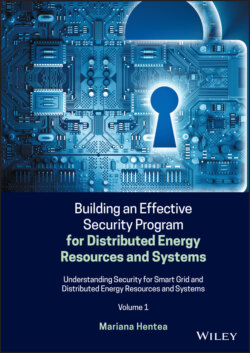Читать книгу Building an Effective Security Program for Distributed Energy Resources and Systems - Mariana Hentea - Страница 92
2.6.1 Need for Cybersecurity Solutions
ОглавлениеCybersecurity solutions for energy infrastructure are imperative for reliable energy delivery. While reliability remains a fundamental principle of grid modernization efforts, reliability requires cybersecurity [Hawk 2014], [P2030 2011]. As the need for cybersecurity increases, this work [Hawk 2014] discusses energy sector partnerships that are designing cybersecurity for the Smart Grid with the vision of surviving a cyber incident while sustaining critical energy delivery functions.
A recently released document [DOE 2014b] provides guidance and requirements for cybersecurity features for the supply chain vendors and manufacturers of equipment, devices, and software used in power systems. Also, NIST's three‐volume document [NISTIR 7628r1] provides guidance to organizations for cybersecurity and privacy strategies, architecture, requirements, supportive analyses, and references.
Ensuring a resilient electric grid is particularly important since it is arguably the most complex and critical infrastructure that other sectors depend upon to deliver essential services. Figure 2.14 is a schematic representation of electricity sector interdependencies with other sectors of the economy. Each infrastructure depends on other infrastructures to function successfully. The potential impact of the increasing threats in the electricity sector is amplified by the connectivity between information systems, the Internet, and other infrastructures, creating opportunities for attackers to disrupt the electricity sector and other critical services such as banks, government, transportation, etc. [GAO 2012].
Figure 2.14 Interdependencies across the economy.
Source: [DHS 2010]. Public Domain.
Over the past two decades, the roles of the electricity sector stakeholders have shifted: generation, transmission, and delivery functions have been separated into distinct markets; customers have become generators using distributed generation technologies; and vendors have assumed new responsibilities to provide advanced technologies and improve security. These changes have created new responsibilities for all stakeholders in ensuring the continued security and resilience of the electric power grid.
